There is nothing quite as uplifting as a branch of cherry blossom silhouetted against a blue spring sky. Japanese cherry blossom trees, known in Japan as sakura, are among the most beautiful of all of the blossom-bearing trees.
You may also like
The Japanese celebrate the arrival of the cherry blossom every year with a blossom festival, known as sakura matsuri. Every year many make pilgrimages to see these iconic trees, planted in famous temple gardens or besides ancient castles, and picnic beneath them to view their blossom – a tradition known as hanami.

The idea of hanami is now catching on in the UK – the National Trust's #BlossomWatch day is usually in April, and the public will be asked to share pictures of beautiful blossoms on social media.
Cherry blossom trees: how to grow
Where to plant a cherry blossom tree
Plant your cherry blossom tree in a sheltered, sunny spot. Be sure to check the height and spread.
Here's how to plant a tree
When to plant a cherry blossom tree
Container-grown cherry blossom trees can be planted all year round, although spring and autumn are best as the soil is warm and moist. You're likely to find container-grown trees at garden centres in the spring. Bare root trees (which are often cheaper) need to be planted during the dormant season, from November to March. These are available from specialist tree nurseries and online.
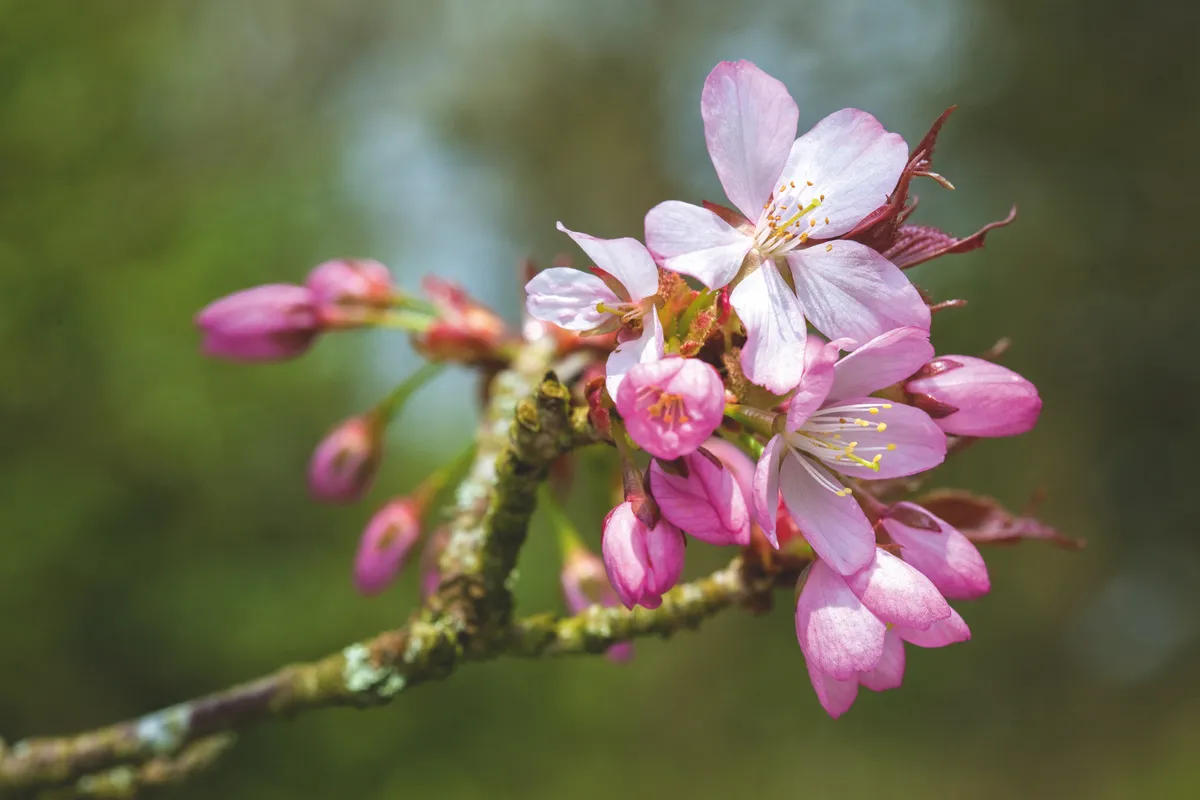
How to prune a cherry blossom tree
Cherry blossom trees do not need pruning, but you can cut out crossing or dead branches in spring or summer, when the tree is less likely to suffer from silver leaf disease or canker.
The best cherry blossom trees
Plant expert Val Bourne selects some favourites from the collection at Batsford Arboretum, with details on how to buy cherry blossom trees.
Prunus 'Pink Shell'

A small, elegant cherry blossom tree with spreading branches that dangle cup-shaped, pale pink, shell-shaped flowers. The blooms turn paler as they age, and as they are single, they are highly attractive to early pollinators. The attractive pale-green, serrated foliage appears at the same time as the flowers and turns beautiful shades of orange before falling in autumn.
From a seedling of uncertain origins, Prunus 'Pink Shell' is one of the loveliest cherries and is widely sold. It's an ideal tree for a lawn or front garden. 4m. RHS H6, USDA 6a-9b.
Prunus 'Tai-haku'
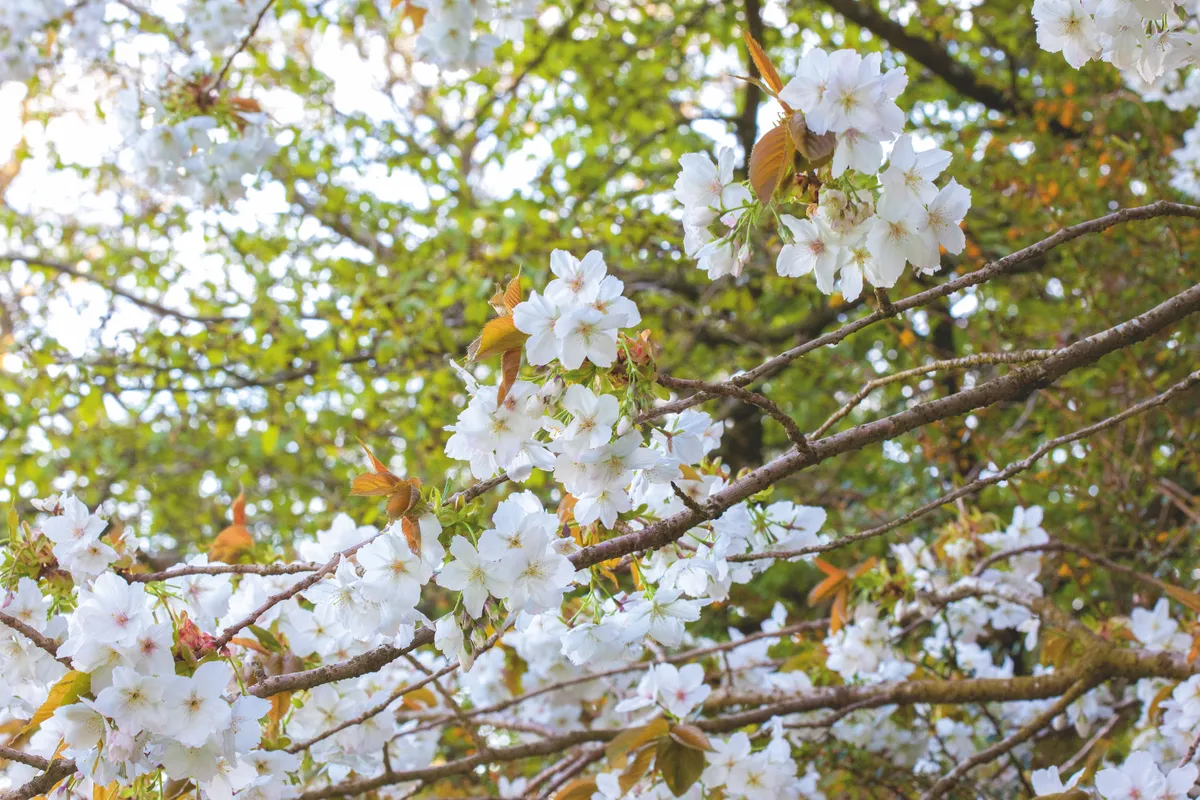
The blossom of this great white cherry looks fabulous when held erect against bronze-green, new leaves. It was reintroduced to Japan by British cherry tree expert Collingwood Ingram. 6m. AGM (Award of Garden Merit). RHS H6, USDA 6a-9b.
Prunus x yedoensis
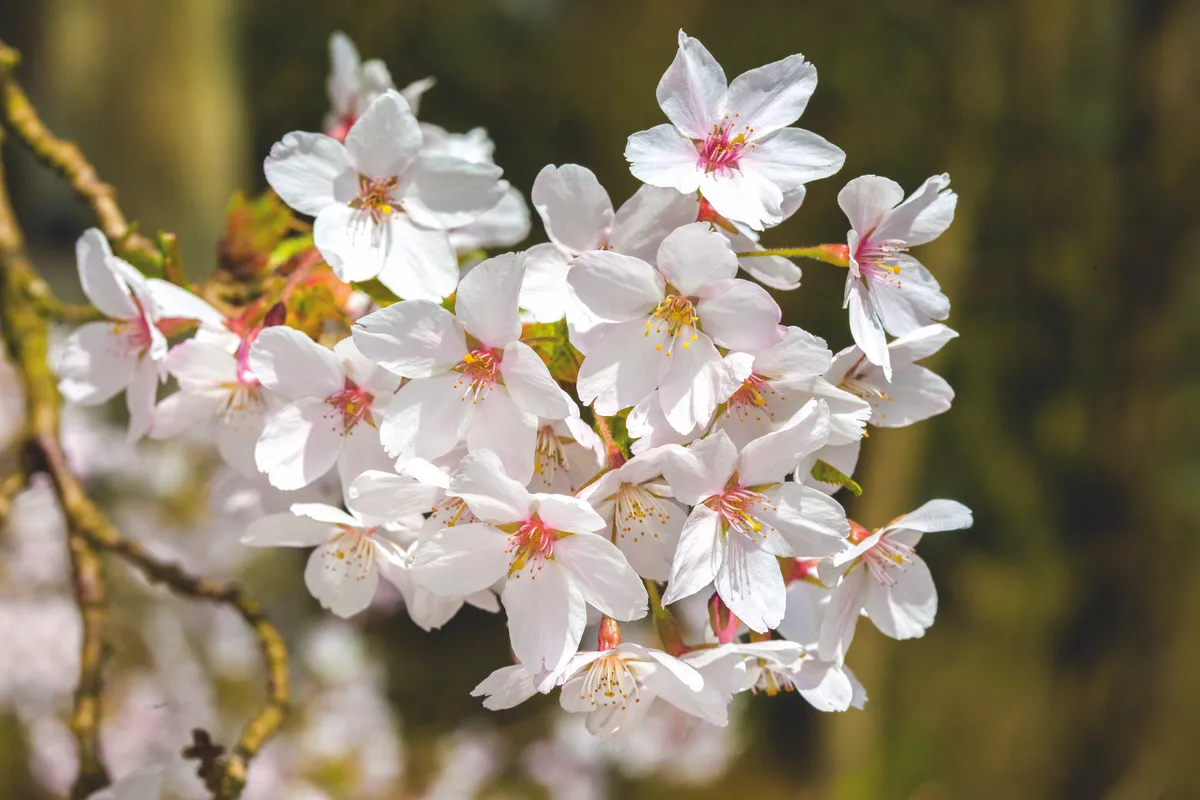
Widely planted in Japan, this cherry blossom tree is short but wide spreading on poorer soil, but it can grow much larger if given better conditions. It has spectacular, almond-scented, blush-pink flowers. 8m. USDA 8a-9a.
Prunus 'Shogetsu'
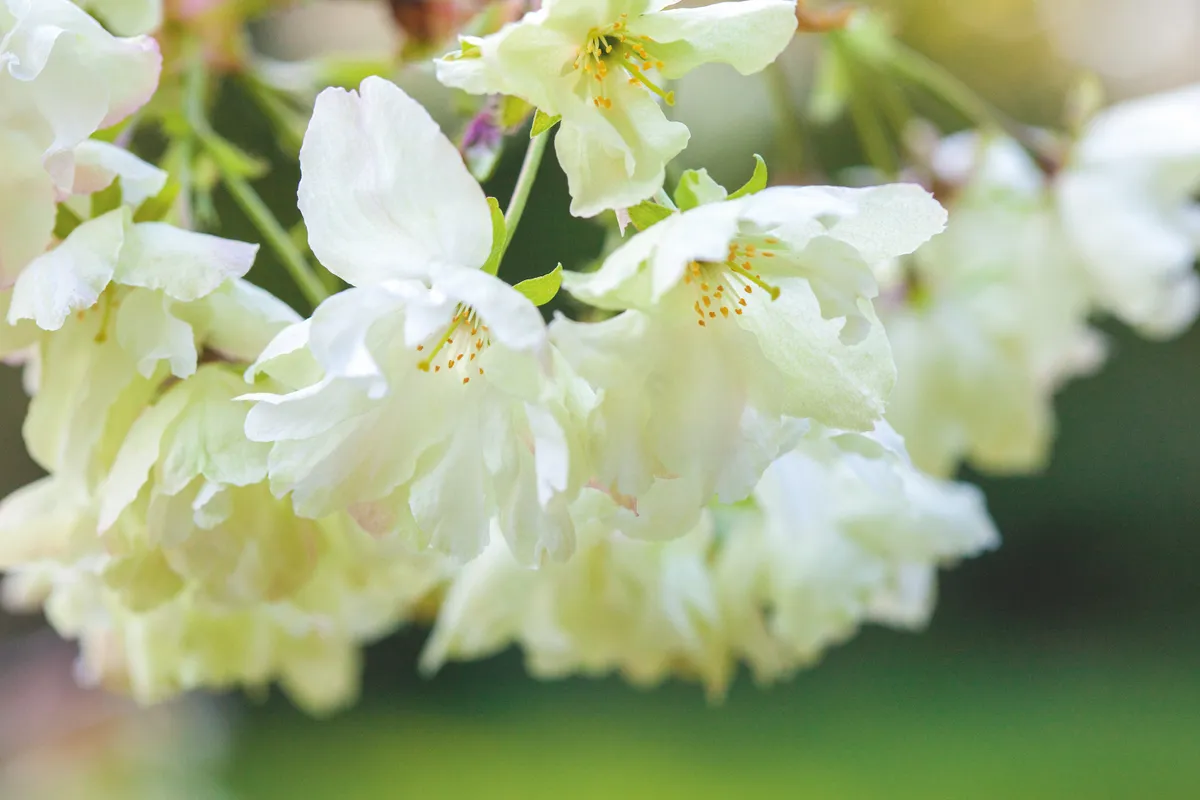
This spreading cherry blossom tree, which is wider than it is tall, flowers later than most. Its light-pink buds, which open to white flowers, are sometimes likened to little ballerinas. Also sometimes known as 'Oky-Miyako'. 4m. AGM. RHS H6, USDA 6a-9b.
Prunus 'Gyoiko'

Its name, which translates as the imperial yellow costume, refers to the delicate, creamy-white colour of its blossom, which resembles the greenish-yellow court robes worn in the emperor’s palace. The cherry tree flowers are also touched with cerise and green so it’s sometimes sold as ‘Tricolor’. Introduced in 1914, it’s similar to the larger-flowered ‘Ukon’. 6m.
Prunus sargentii

A large, early flowering cherry blossom tree with substantial, single pink flowers that appear in March as new foliage opens to bronze. Good autumn colour follows, when the leaves turn maroon-red. It’s named after the American botanist Charles Sprague Sargent.
12m. USDA 4a-7b.
Prunus incisa 'Fujimae'
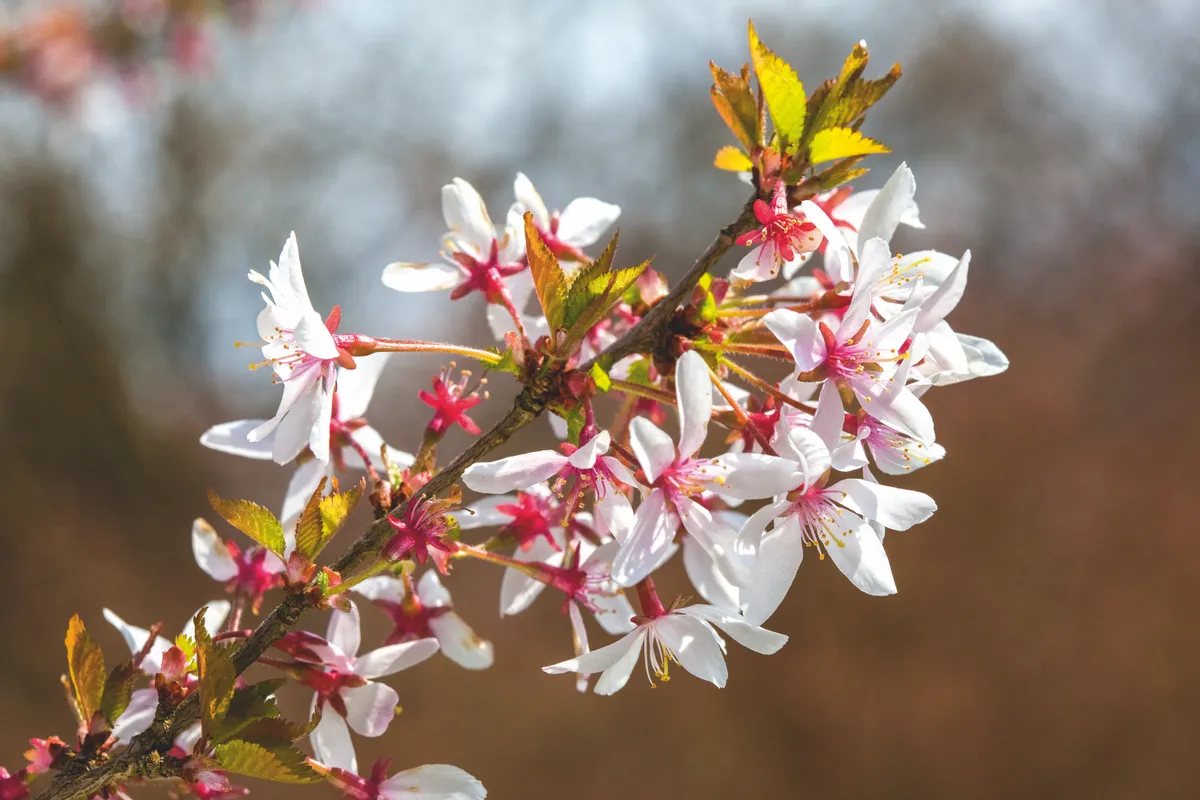
A large, slow-growing shrub or very small cherry blossom tree that is smothered with pale-pink buds that open to white in early spring. Colours up to orange in autumn and could be grown in a container. 3m. AGM. RHS H6.
Prunus 'Fudan-zakura'

A small tree that, unlike most Japanese cherries, doesn’t blaze with lots of flowers at the same time. Instead between November and April, a succession of pink buds appear, which develop into blush-white flowers. 8m.
Prunus 'Umineko'

This stunning white cross between P. speciosa and P. incisa, was bred by the British cherry blossom tree expert Collingwood Ingram in 1928. The April flowers are pure-white on an upright tree, and its name translates as seagull. 8m.
Prunus 'Kiki-shidare-zakura'

Fully double, pink cherry blossom appears as the new leaves break on branches that cascade downwards to form an umbrella. The green foliage also has attractive bright-red stems. 3m. USDA 3a-8b.
Buy Prunus 'Kiki-shidare-zakura' from Primrose
Prunus 'Pink Perfection'

Raised in 1935 at Waterers nursery in Surrey, and thought to be a hybrid seedling of ‘Shogetsu’ and ‘Kwanzan’. Its rose-pink, very double flowers last longer than most, beginning in early May. 5m. AGM. RHS H6.
Prunus 'Hokusai'
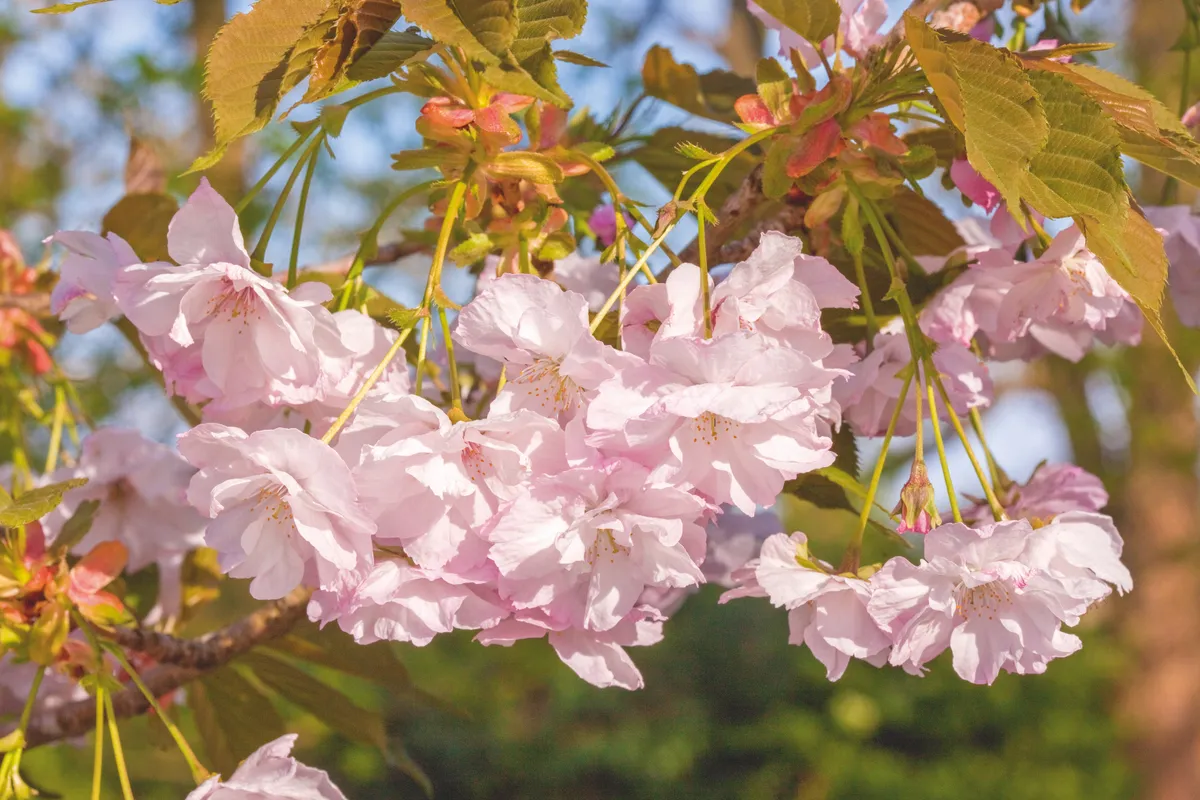
This pink cherry blossom has a hint of apricot to its flowers. A vigorous, spreading tree, smothered in large, semi-double, pale-pink flowers that show up well against brownish-bronze leaves. 8m. AGM. RHS H6
Prunus 'Edo-zakura'

This April-flowering cherry blossom tree has been grown in Japan since the the 17th century; its name is the former name for Tokyo. It is the best known of the pink frilly cherries with an inner tier of petals that is almost white. 5-6m.
Prunus 'Kiku-shidare-zakura'

Its flowers open slowly and peak in May, offering densely packed, soft-pink petals. The name means chrysanthemum cherry and is a tree the cherry expert Collingwood Ingram found to be ‘slow and stubborn’. 3m.
Prunus 'Horinji'

Its name refers to an ancient Buddhist temple in Kyoto. The soft-pink, semi-double cherry blossom flowers are held in purplish buds so the neatly arranged flowers on this small, upright tree have a unique two-tone effect. 5m.
Prunus 'Shosar'
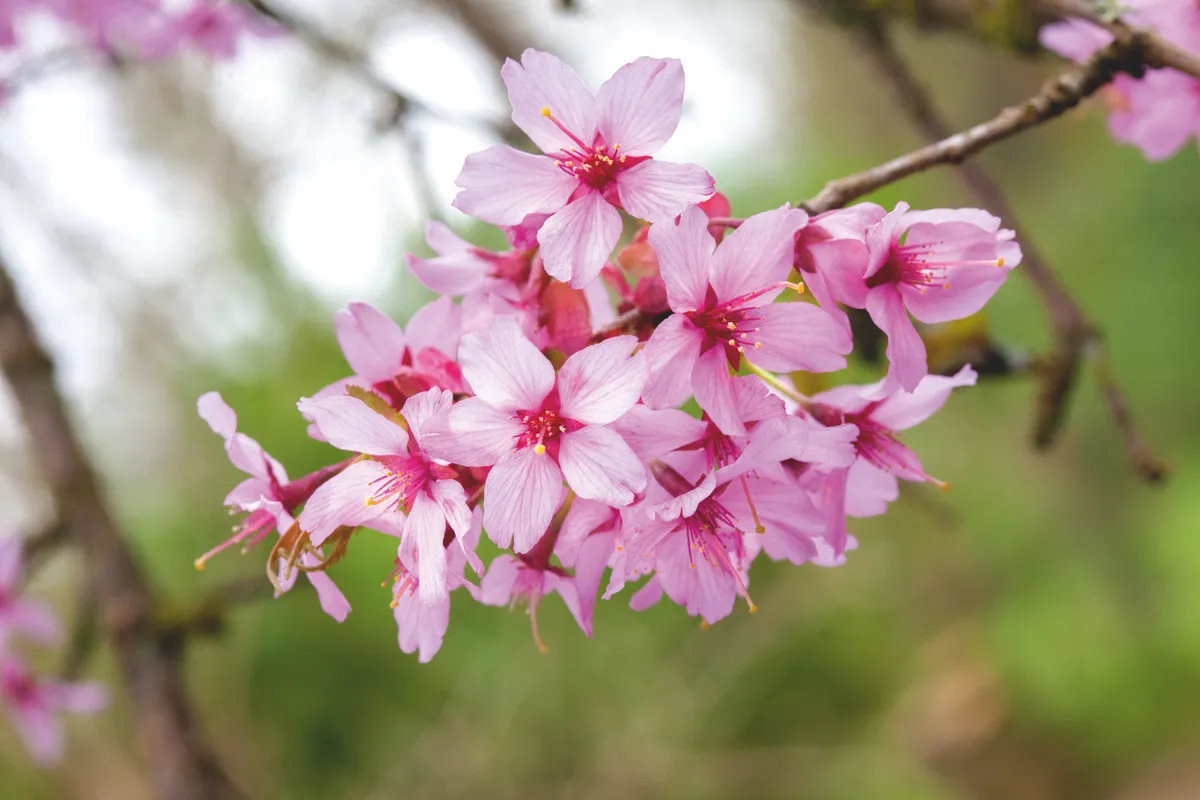
This strong fastigiate cherry blossom tree – a cross between a P. incisa x P. campanulata hybrid and P. sargentii – was bred by Collingwood ‘Cherry’ Ingram. It bears beautiful pink blossom in early March. 12m. AGM. RHS H6.
Buy Prunus 'Shosar' from Primrose
Prunus ‘Takasago’

‘Takasago’ refers to a song associated with an ancient Japanese card game. The abundant pink cherry blossom tree, held in clusters of three to six flowers, appears in April against young bronzed foliage on a slow-growing tree. 3m.
Prunus 'Shirotae'
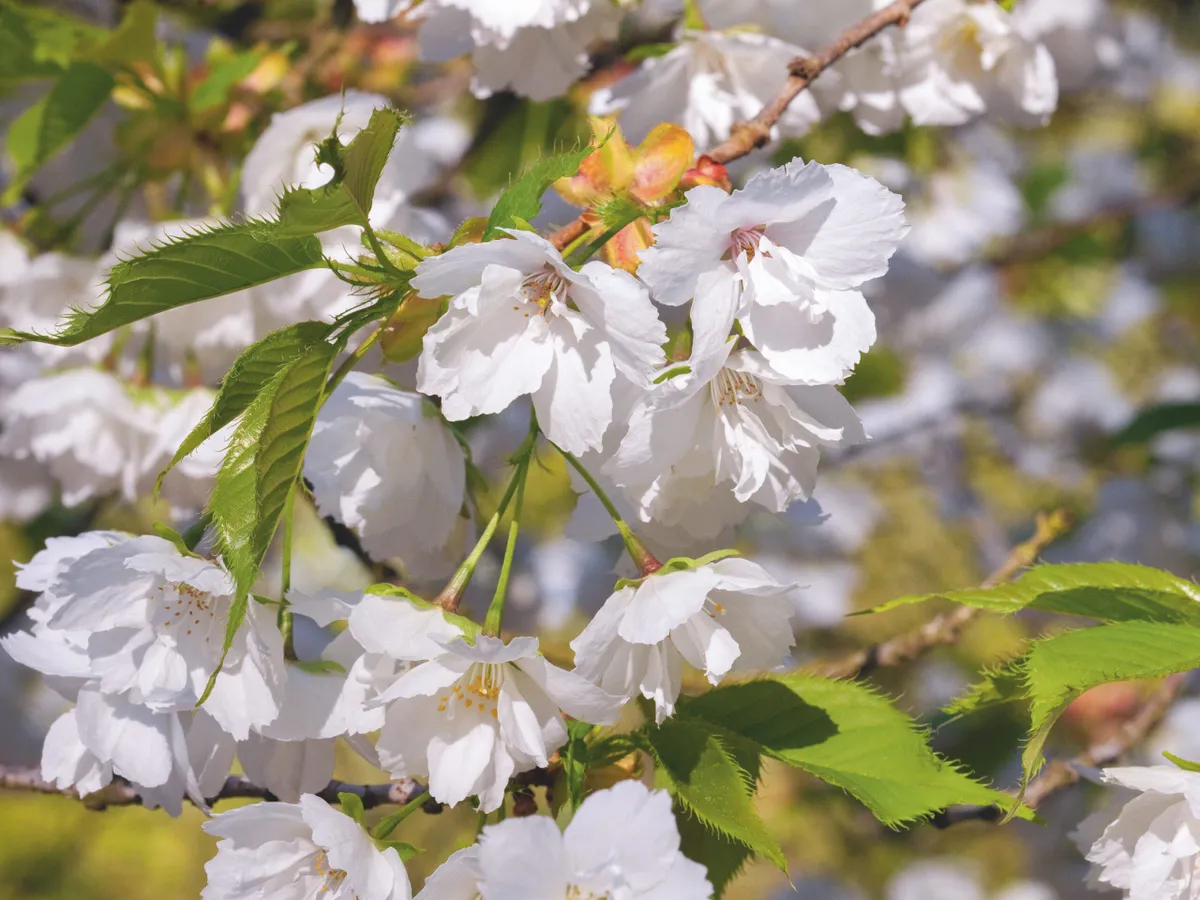
A vigorous, strong cherry blossom tree with an unmistakable flat-topped, spreading habit and pure-white, semi-double, fragrant flowers. It’s one of the earliest cherry trees to flower in spring.
As the blooms fade, the pale green, long-toothed leaves emerge. These become darker as they age over the summer, then produce a vivid orange and red display in the autumn before falling. Prunus 'Shirotae' is a good choice for a medium-sized garden or a Japanese-style garden. It looks good grown as a specimen tree in a lawn.
10m. AGM. RHS H6, USDA 6a-9b.
Where to see cherry blossom trees
Batsford Arboretum, near Moreton-in-Marsh in the Cotswolds, holds an extensive Plant Heritage collection of Japanese cherry blossom trees. These are planted in an oriental setting complete with an authentic Japanese rest house and a traditional bridge. Japanese cherry trees have been planted at Batsford since the 1960s, so the garden boasts a large collection displayed to perfection on the south-facing slope. Most cherry blossom trees flower in April, when many magnolias are out too, making for a stunning display.
Batsford Arboretum, Moreton-in-Marsh, Gloucestershire GL56 9QB.
Brogdale Farm
Home of the National Fruit Collection with over 400 cherry varieties alone. Along with the cherry trees there are other blossoming fruit trees including apples, pears, quince and plums. Guided Blossom Tours are taking place on 5th, 6th, 26th and 27th of April 2025 at 11.30pm and 2pm. Hanami Blossom Weekend is 12th-13th April.
Brogdale Road, Faversham, Kent ME13 8XZ.
Tel 01795 536250, www.brogdalecollections.co.uk
Cotehele
The estate at Cotehele boasts an eight-acre meadow planted with varieties of local apple and cherries. The orchard is key to the National Trust’s recent campaign to preserve traditional orchards and bring them back to working use. The National Trust runs a Festival of Blossom across many of its gardens - go to the website to find out more and discover which activities and events are taking place near you.
St Dominick, nr Saltash, Cornwall PL12 6TA
Tel 01579 351346, www.nationaltrust.org.uk
The Royal Botanic Gardens, Kew
Enjoy cherries but also the blossom of plums and peaches (all Prunus) to apples and crabs (Malus) and pears (Pyrus) across the site, underplanted with bulb displays, and especially around the Pagoda.
Open daily from 9.30am
Kew, Richmond, Surrey TW9 3AB
Tel 020 8332 5655, www.kew.org
With all garden suggestions it is worth contacting them before visiting or checking their social media or website blossom watch pages to get up-to-date details of how their blossom displays are progressing.




